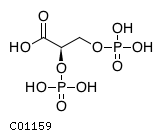
CHEBI:17720
| Name | 2,3-bisphospho-D-glyceric acid |  Download: mol | sdf |
| Synonyms | 0(2r)-2,3-bis(phosphonatooxy)propanoate; 2,3-bisphospho-d-glycerate; 2,3-bisphospho-d-glyceric acid; 2,3-bpg; 2,3-disphospho-d-glycerate; D-greenwald ester; Dpg; | |
| Definition | The D-enantiomer of 2,3-bisphosphoglyceric acid. | |
| Molecular Weight (Exact mass) | 266.0371 (265.9593) | |
| Molecular Formula | C3H8O10P2 | |
| SMILES | OC(=O)[C@@H](COP(O)(O)=O)OP(O)(O)=O | |
| InChI | InChI=1S/C3H8O10P2/c4-3(5)2(13-15(9,10)11)1-12-14(6,7)8/h2H,1H2,(H,4,5)(H2,6,7,8)(H2,9,10,11)/t2-/m1/s1 | |
| InChI Key | XOHUEYCVLUUEJJ-UWTATZPHSA-N | |
| Crosslinking annotations | KEGG:C01159 | 3DMET:B01397 | ChEBI:17720 | NIKKAJI:J2.731.659J | PDB-CCD:DG2 | PubChem:4387 | |
| Pathway ID | Pathway Name | Pathway Description (KEGG) |
| map00010 | Glycolysis / Gluconeogenesis | Glycolysis is the process of converting glucose into pyruvate and generating small amounts of ATP (energy) and NADH (reducing power). It is a central pathway that produces important precursor metabolites: six-carbon compounds of glucose-6P and fructose-6P and three-carbon compounds of glycerone-P, glyceraldehyde-3P, glycerate-3P, phosphoenolpyruvate, and pyruvate [MD:M00001]. Acetyl-CoA, another important precursor metabolite, is produced by oxidative decarboxylation of pyruvate [MD:M00307]. When the enzyme genes of this pathway are examined in completely sequenced genomes, the reaction steps of three-carbon compounds from glycerone-P to pyruvate form a conserved core module [MD:M00002], which is found in almost all organisms and which sometimes contains operon structures in bacterial genomes. Gluconeogenesis is a synthesis pathway of glucose from noncarbohydrate precursors. It is essentially a reversal of glycolysis with minor variations of alternative paths [MD:M00003]. |
| map01100 | Metabolic pathways | NA |

